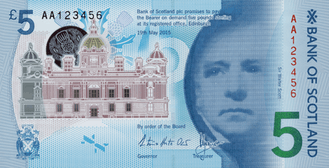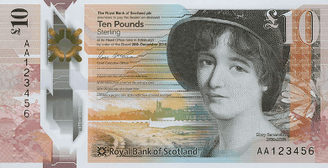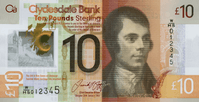Banknotes of Scotland
Banknotes of Scotland are the banknotes of the Pound Sterling that are issued by the Scottish banks and in circulation in Scotland. The issuing of banknotes by retail banks in Scotland is subject to the Bank Charter Act 1844, the Banknotes (Scotland) Act 1845, the Currency and Bank Notes Act 1928, and the Coinage Act 1971. Currently, three retail banks are allowed to print notes for circulation in Scotland: Bank of Scotland, Royal Bank of Scotland, and Clydesdale Bank.
Scottish banknotes are unusual, first because they are issued by retail banks, not central banks, and second, because they are technically not legal tender anywhere in the United Kingdom – not even in Scotland.[1][2] As such, they are classified as promissory notes, and the law requires that the issuing banks hold a sum of Bank of England banknotes or gold equivalent to the total value of notes issued.[3][4]
The fact that the notes are not defined as legal tender means that they are not withdrawn from circulation in the same way as the Bank of England notes, which cease to be legal tender on a given date. Instead the Scottish banks withdraw old notes from circulation as they are banked. Any notes still in circulation continue to be honoured by banks,[5] but retailers may refuse to accept older notes.[6]
Banknotes
Bank of Scotland notes

All Bank of Scotland notes bear a portrait of Sir Walter Scott on the front in commemoration of his 1826 Malachi Malagrowther campaign for Scottish banks to retain the right to issue their own notes. [7] The Bank of Scotland's 2007 series of banknotes is known as the Bridges of Scotland series. These notes were introduced on 17 September 2007, and show Scotland's most famous bridges on the reverse side. From 2016, the Bridges of Scotland series is being renewed with the issue of new polymer notes with designs that follow the same basic theme of "bridges". The Tercentenary and 2007 series of notes are being withdrawn from circulation and replaced with the polymer series as these are issued, but older notes continue to be accepted at banks. In line with this, the Committee of Scottish Bankers encouraged the public to spend or exchange non-polymer five and ten pound notes before 1 March 2018.[6]

Following the announcement that HBOS (Bank of Scotland's parent company) would be taken over by Lloyds TSB in September 2008, it was confirmed that the new banking company would continue to print bank notes under the Bank of Scotland name.[8] According to the Bank Notes (Scotland) Act 1845, the bank could have lost its note-issuing rights, but by retaining headquarters within Scotland, banknote issue continued.[9]
| Image | Denomination | Obverse | Reverse |
|---|---|---|---|
| Tercentenary Series (1995) | |||
| £5 | Sir Walter Scott | Vignette of oil and energy | |
| £10 | Vignette of distilling and brewing | ||
| £20 | Vignette of education and research | ||
| £50 | Vignette of arts and culture | ||
| £100 | Vignette of leisure and tourism | ||
| Bridges of Scotland Series (2007) | |||
| £5 | Sir Walter Scott | Brig o' Doon | |
| £10 | Glenfinnan Viaduct | ||
| £20 | Forth Bridge | ||
| £50 | Falkirk Wheel | ||
| £100 | Kessock Bridge | ||
| Polymer Series (2016 onwards) | |||
| £5 | Sir Walter Scott | Brig o' Doon | |
| £10 | Glenfinnan Viaduct | ||
Royal Bank of Scotland notes

As of August 2017, the Royal Bank of Scotland is in the process of adopting a new series of banknotes. These will be made of polymer. Two (the £5 and £10 notes) have already been released, whilst a new £20 note is being designed. The £5 note shows Nan Shepherd on the obverse accompanied by a quote from her book 'The Living Mountain', and the Cairngorms in the background. The reverse displays two mackerel, with an excerpt from the poem ‘The Choice’ by Sorley MacLean.[10] The obverse of the £10 note shows Mary Somerville, with a quote from her work 'The Connection of the Physical Sciences', and Burntisland beach in the background. The reverse displays two otters and an excerpt from the poem ‘Moorings’ by Norman MacCaig.[11] The obverse of the £20 note, to be introduced in 2020, will show Catherine Cranston. [12]

The previous series of Royal Bank of Scotland notes, originally issued in 1987, remains in circulation, although it is now in the process of being replaced by polymer notes: the Committee of Scottish Bankers encouraged the public to spend or exchange non-polymer five and ten pound notes before 1 March 2018.[6]. On the front of each note is a picture of Lord Ilay (1682–1761), the first governor of the bank, based on a portrait painted in 1744 by the Edinburgh artist Allan Ramsay.[13] The front of the notes also features an engraving of the bank's former headquarters in St Andrew Square, Edinburgh. The background graphic on both sides of the notes is a radial star design which is based on the ornate ceiling of the banking hall in the old headquarters building.[14] On the back of the notes are images of Scottish castles, with a different castle for each denomination.
Occasionally the Royal Bank of Scotland issues commemorative banknotes. Examples are the £1 note issued to mark the 150th anniversary of the birth of Alexander Graham Bell in 1997, the £20 note for the 100th birthday of Queen Elizabeth The Queen Mother in 2000, the £5 note honouring veteran golfer Jack Nicklaus in his last competitive Open Championship at St Andrews in 2005, and the £10 note commemorating HM Queen Elizabeth II's Diamond Jubilee in 2012. These notes are much sought after by collectors, and they rarely remain long in circulation.
| Image | Denomination | Obverse | Reverse |
|---|---|---|---|
| Ilay Series (1987) | |||
| £1 | Lord Ilay | Edinburgh Castle | |
| £5 | Culzean Castle | ||
| £10 | Glamis Castle | ||
| £20 | Brodick Castle | ||
| £50 | Inverness Castle (introduced 2005) | ||
| £100 | Balmoral Castle | ||
| Polymer Series (2016 onwards) | |||
| £5 | Nan Shepherd | Mackerel | |
| £10 | Mary Somerville | Otters | |
Clydesdale Bank notes

Clydesdale Bank has three series of banknotes in circulation at present. The most recent set of notes, the Polymer series, came into circulation in March 2015, when the Clydesdale Bank became the first bank in Great Britain to issue polymer banknotes. The £5 commemorative notes, issued to mark the 125th anniversary of the construction of the Forth Bridge, contain several new security features including a reflective graphic printed over a transparent "window" in the banknote.[15][16] Further notes in the polymer series will be introduced over time, replacing the previous paper notes: the public are being encouraged to spend or exchange non-polymer five and ten pound notes before 1 March 2018.[6]

The polymer notes continue the theme of the World Heritage Series of paper banknotes, introduced in autumn 2009. The new notes each depict a different notable Scot on the front and on the reverse bear an illustration of one of Scotland's UNESCO World Heritage Sites.[17]

Banknotes of the earlier Famous Scots Series portray notable Scottish historical people along with items and locations associated with them.[18]
The Clydesdale Bank also occasionally issues special edition banknotes, such as a £10 note celebrating the bank's sponsorship of the Scotland team at the 2006 Commonwealth Games.
| Image | Denomination | Obverse | Reverse |
|---|---|---|---|
| Famous Scots Series | |||
| £5 | Robert Burns | Vignette of a field mouse from Burns' poem To a Mouse | |
| £10 | Mary Slessor | Vignette of a map of Calabar, Nigeria, and African missionary scenes | |
| £20 | King Robert the Bruce | Vignette of the Bruce on horseback with the Monymusk Reliquary against a background of Stirling Castle | |
| £50 | Adam Smith | Vignette of industrial tools against a background of sailing ships | |
| £100 | Lord Kelvin | Vignette of the University of Glasgow | |
| World Heritage Series (2009) | |||
| £5 | Sir Alexander Fleming | Vignette of St Kilda | |
| £10 | Robert Burns | Vignette of Edinburgh Old and New Towns | |
| £20 | King Robert the Bruce | Vignette of New Lanark | |
| £50 | Elsie Inglis | Vignette of the Antonine Wall | |
| £100 | Charles Rennie Mackintosh | Vignette of Neolithic Orkney | |
| Polymer Series (2015 onwards) | |||
| £5 | Sir William Arrol | Vignette of the Forth Bridge | |
| £10 | Robert Burns | Vignette of Edinburgh Old and New Towns | |
See also
References
- ↑ Bank of England- Frequently Asked Questions. "Are Scottish & Northern Irish notes legal tender?". Archived from the original on 12 October 2007. Retrieved 2007-10-14.
- ↑ "Legal Tender Guidelines". Royal Mint. Archived from the original on 17 December 2008. Retrieved 2008-11-08.
- ↑ "No. 58254". The London Gazette. 21 February 2007. p. 2544.
- ↑ "Scottish voters in favour of keeping the pound". Daily Express. 12 March 2017. Retrieved 2017-04-20.
- ↑ "What to do with Scottish Paper £5 notes". Committee of Scottish Bankers. Retrieved 2017-08-22.
- 1 2 3 4 "Four-week deadline to use Scottish paper money". BBC News. 2018-02-05. Retrieved 2018-02-05.
- ↑ "Malachi Malagrowther and the Scottish banknote". BBC. 22 April 2017. Retrieved 2017-08-25.
- ↑ McIntosh, Lindsay; MacDonell, Hamish (19 September 2008). "Takeover 'may tip economy of Scotland into turmoil'". The Scotsman. Edinburgh. Archived from the original on 21 September 2008. Retrieved 2008-09-20.
- ↑ MacLeod, Angus (18 September 2008). "Salmond rallies bank chiefs to rescue Scottish jobs". The Times. London. Retrieved 2008-09-20.
- ↑ "New RBS bank notes to feature Nan Shepherd and Mary Somerville". The Scotsman. 25 April 2016. Retrieved 25 April 2016.
- ↑ "RBS to issue polymer £10 banknote in October". BBC. 11 August 2017. Retrieved 11 August 2017.
- ↑ "New RBS bank notes to feature Nan Shepherd and Mary Somerville". The Scotsman. 25 April 2016. Retrieved 25 April 2016.
- ↑ "Archibald Campbell [Mac Cailein Mòr], 3rd Duke of Argyll, 1682 – 1761. Statesman". National Galleries of Scotland – Scottish National Portrait Gallery. 2008. Retrieved 2013-04-27.
- ↑ "Our Banknotes – The Ilay Series". The Royal Bank of Scotland Group. 2008. Archived from the original on 26 January 2013. Retrieved 2013-04-27.
- ↑ "Clydesdale Bank brings in plastic £5 notes". BBC News. 23 March 2015. Retrieved 23 March 2015.
- ↑ "Plastic £5 notes released by Clydesdale Bank in first for Scotland". STV. 23 March 2015. Retrieved 23 March 2015.
- ↑ "Clydesdale launches Homecoming bank notes – Herald Scotland". Theherald.co.uk. 14 January 2009. Archived from the original on 14 February 2009. Retrieved 2010-04-09.
- ↑ "Current Banknotes : Clydesdale Bank". Committee of Scottish Bankers. Retrieved 27 April 2013.